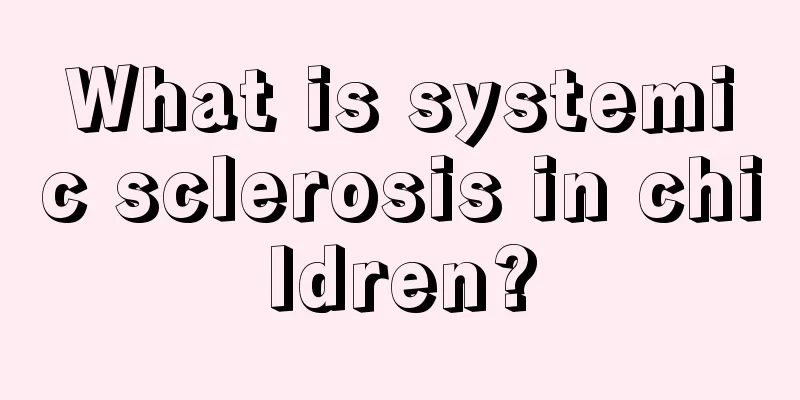What is systemic sclerosis in children?

|
Children are treasures in every parent’s heart. Therefore, in many cases, once a child is sick, parents will feel very sad and even want their children’s diseases to happen to themselves. There is a disease called childhood systemic sclerosis. What kind of disease is it? I believe many parents are very curious, so today I will give you a brief introduction. I hope it will be useful to everyone! Clinically, systemic sclerosis can be divided into the following four types: (1) Diffuse scleroderma It is relatively common, manifested by symmetrical tightening, hardening, and thickening of the skin on the limbs and face, which can affect the proximal limbs, neck, and trunk, and is accompanied by damage to internal organs such as the gastrointestinal tract, kidneys, lungs, and heart. This type is characterized by rapid onset, rapid progression of skin lesions, early onset of visceral damage, and poor prognosis; laboratory tests can show positive anti-Scl-70 antibodies and anti-centromere antibodies may also be positive. (2) Acromial sclerosis The skin changes of this type are limited to the distal limbs such as fingers, forearms, distal lower limbs and face. The skin in the above parts becomes symmetrically tight, hard and thick, which may be accompanied by Raynaud's phenomenon. In the later stage of the disease, pulmonary hypertension and amputation-like changes may occur. Some patients show CREST syndrome with prominent manifestations of calcification and capillary dilation of the skin and subcutaneous tissue. The prognosis of this type is relatively good, with a 10-year survival rate of more than 70%; laboratory tests show positive anti-centromere antibodies. (3) Overlap syndrome When diffuse or localized systemic sclerosis is combined with one or more other connective tissue diseases, it is called overlap syndrome. (4) Systemic sclerosis without skin sclerosis Patients of this type only have visceral lesions without skin sclerosis, which may manifest as: ① esophageal motility disorder, duodenal dilatation, and colon pouch formation ② Raynaud's phenomenon, nail fold capillary dilatation, esophageal motility disorder, and oliguric renal failure ③ The above symptoms are accompanied by pulmonary hypertension or interstitial lung lesions. This type of patient is rare, less than 1%. Scleroderma is a connective tissue disease characterized by localized or diffuse fibrosis, sclerosis and atrophy of the connective tissue of the skin and internal organs. Its main features are fibrosis or sclerosis of the skin, synovium, skeletal muscle, blood vessels and esophagus. Some internal organs, such as the lungs, heart, kidneys, and large and small arteries may also have similar lesions. Some patients only develop skin sclerosis, which is called localized scleroderma; while some patients also develop fibrosis and sclerosis of internal organs such as the heart, lungs, gastrointestinal tract and kidneys. This condition is called systemic sclerosis, which is often serious and has a poor prognosis. This disease ranks second only to lupus erythematosus among connective tissue diseases. Most patients are female, with a female to male ratio of approximately 3:1. The age of onset is mostly between 20 and 50 years old. The disease is most common in women of childbearing age, but children and the elderly can also develop the disease. There are reports that miners and workers exposed to silicon have more cases of scleroderma. In fact, many times, some of the children’s illnesses cannot be cured just by the parents’ attention. Sometimes, our children themselves need to pay attention to them. Therefore, I suggest that parents cultivate their children’s ability to solve problems by themselves. Only in this way can parents feel at ease! |
<<: What should we do if children have deformed teeth?
>>: What are the benefits of physical exercise for young children?
Recommend
What should babies with weak spleen and stomach eat?
The baby's body is relatively delicate. If th...
The three "sorrows" of Chinese parents' parenting
To sum up the parents' experience in family e...
Small pimples on baby's eyelids
Whether it is an adult or a baby, the skin around...
How to choose toys for two-month-old babies?
The growth of the baby is of great concern to all...
Will it be okay for a baby to sleep with his head tilted when he grows up? ...
In life, many parents think that it is okay for c...
How to balance the baby's armpit temperature
Nowadays, infant diseases are rampant and many in...
What are childhood mental illnesses?
When it comes to mental illness, everyone will be...
8 month old baby's daily milk intake
Babies grow very fast. In the blink of an eye, he...
What causes sinusitis in children?
Nowadays, sinusitis is a disease that many of our...
Why do new teeth not grow for a year when they are replaced?
Generally speaking, children will have all their ...
6 tips to help you raise a child with money
After having children, many mothers cut down on t...
Four things that babies need when using air conditioning in summer
In the hot summer, parents are very worried about...
Symptoms of precocious puberty in girls
The growth and development of babies follow certa...
What to do if your 40-day-old baby has a cough
Babies always encounter various problems during t...
How to treat diarrhea in infants and young children?
Infant diarrhea is also called infant indigestion...









